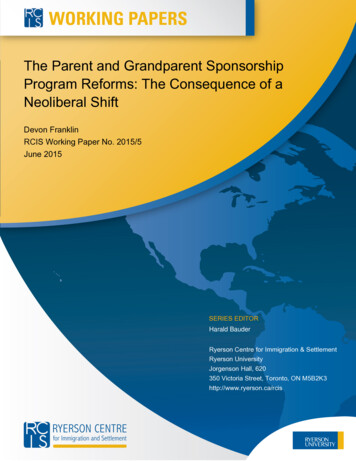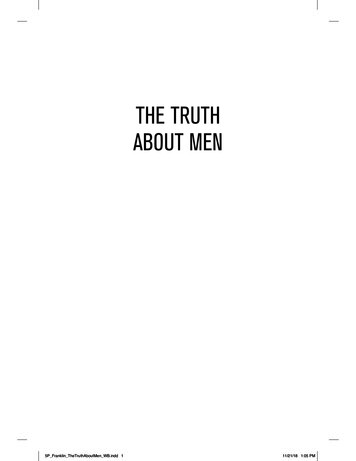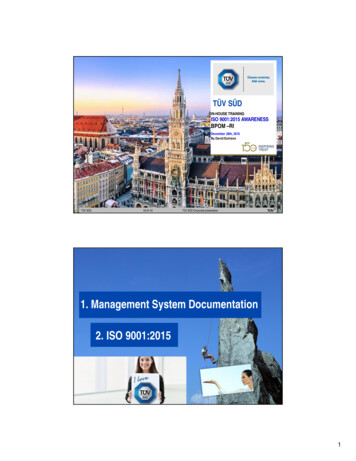
Transcription
The Parent and Grandparent SponsorshipProgram Reforms: The Consequence of aNeoliberal ShiftDevon FranklinRCIS Working Paper No. 2015/5June 2015SERIES EDITORHarald BauderRyerson Centre for Immigration & SettlementRyerson UniversityJorgenson Hall, 620350 Victoria Street, Toronto, ON M5B2K3http://www.ryerson.ca/rcis
RCIS Working PaperNo. 2015/5The Parent and Grandparent Sponsorship Program Reforms:The Consequence of a Neoliberal ShiftDevon FranklinSeries Editor: Harald BauderRCIS Working Papers present scholarly research of all disciplines on issues related toimmigration and settlement. The purpose is to stimulate discussion and collect feedback. Theviews expressed by the author(s) do not necessarily reflect those of RCIS. For a complete list ofRCIS publications, visit www.ryerson.ca/rcisISSN: 1929-9915Creative Commons Attribution-Noncommercial-No Derivative Works 2.5 CanadaLicense
D. FranklinAbstractSince the formal enshrinement of Canada’s immigration objectives in the ImmigrationAct of 1976, Citizenship and Immigration Canada has been tasked with theresponsibility of balancing the demands of the labour market and reuniting immigrantfamilies. Policy changes in the 1990s suggest that neoliberal ideology, which promotesmarket economy principles, has become increasingly influential in the shaping ofCanadian social policies and practices, and has had significant implications forimmigration policy and admission trends (Arat-Koc, 1999). The prominence of neoliberallogic in immigration policy has resulted in the framing of immigrant value in terms ofeconomic contributions. As a result, Family Class admissions have been the target ofcriticism, particularly sponsored parents and grandparents, who are absolved ofmeeting the point system criteria and are therefore perceived as having little ability tocontribute to the economy (McLaren & Black, 2005). This paper explores the extent towhich recent reforms to the parent and grandparent sponsorship program are areflection of, and maintain, the prevailing neoliberal discourse that subordinates FamilyClass immigrants, especially parents and grandparents, conceiving of them as burdensto the state as opposed to contributing Economic Class entrants. This economicframework provides an incomplete picture of the contributions that sponsored parentsand grandparents make to Canada. Furthermore, the insufficiency of empirical datasupporting the claim that parents and grandparents are a potential burden on the statesuggests that the recent reforms are an explicit expression of fear rather than fact(VanderPlaat, Ramos & Yoshida, 2011). This paper concludes with future researchsuggestions that lend themselves to redefining “contribution” to incorporate social,cultural, and indirect economic contributions, to provide a more nuanced conception ofthe value of sponsored parents and grandparents.Editor’s NoteThis paper received the Best Term Paper Award for 2014-15 of the Master’s Program inImmigration and Settlement Studies, an annual award granted by the Faculty ofCommunity Services. The award was delivered by Dean Usha George at the 10thAnniversary Gala of the ISS MA Program, May 1, 2015.IntroductionIn September 2011, Immigration Minister Jason Kenney announced the impendinginitiation of Phase I of the Action Plan for Faster Family Reunification, emphasizing thatthe objective of the redesign of the parent and grandparent sponsorship program was tocut backlog and subsequent wait times, to reunite families quicker with their loved ones.However, in a conference in May 2013, preceding his announcement of Phase II,Kenney’s rhetoric was less concerned with reuniting families, and more concerned with“deal[ing] with some of the abuse of [the government’s] generosity in the parent andgrandparent sponsorship program” (qtd. in CIC, 2013). In particular, Kenney alluded tothe additional social welfare and healthcare costs that sponsored elderly immigrantsincur against the state. Despite Canada’s obligation to family reunification, as specifiedin the Immigration Act of 1976 and reaffirmed in the revised Immigration and RefugeeProtection Act of 2002, the government’s commitment to supporting certain groups ofsponsored relatives has limits (Kelley & Trebilcock, 2010). The new reforms maintain1
RCIS Working Paper No. 2015/5previous provisions to ensure family reunification, but the regulations imposed on thesponsor are far more stringent, emphasizing economic capacity, directly correspondingwith the government’s concern for ensuring that sponsored immigrants do not becomedependent on the state.Despite being initially framed as a response to the overwhelming backlog ofapplications, the imposed changes to the parent and grandparent sponsorship programover-emphasize the responsibility of the sponsor as the sole supporter of the sponsoredrelative. When the state distances itself from any responsibility for sponsored relatives,financial or otherwise, this calls into question the value that it places on familyreunification. To adequately understand the reforms to the parent and grandparentsponsorship program, an exploration of the previous decade of Family Classreformations is necessary. In this paper, I will explore the recent history of immigrationpolicy changes, particularly in the 1990s, which were characterized by diminishingopportunities to immigrate within the Family Class due to an emerging neoliberalideology, which emphasized fulfilling labour market needs as the purpose ofimmigration. From this historical context, the new reforms will be contextualized, andanalysis will illustrate that neoliberalism has prevailed and directed immigration policyreforms and admission trends into the current period. Finally, I will challenge the narroweconomic logic that operates within the pervasive neoliberal paradigm to suggest that aconcept of contribution based solely on an economic calculation neglects and devaluesthe more complex contributions that parents and grandparents make to their familiesand larger communities. Most importantly, empirical evidence supporting argumentsboth for and against the sponsorship of parents and grandparents is limited at best.Future research needs to adopt a more holistic approach to contribution to effectivelyweigh the costs and benefits of parent and grandparent sponsorship, and ensure thatpolicy reforms are informed by the actual experiences of those most impacted.Immigration Policy in TransitionDespite the long-history of immigration to Canada, the goals of Canadian immigrationpolicy were not formally articulated until the Immigration Act of 1976. The primaryobjectives of Canadian immigration were to maintain a strong and viable economy,reunite families, and fulfill international obligations with respect to refugees. Immigrantswere categorized based on the objectives they fulfilled: Economic Class, Family Class,and Humanitarian Class respectively (Kelley & Trebilcock, 2010). However, what wascrucially unclear and led to much debate was the proportion of entrants that wouldrepresent each of these newly established categories. The debates regarding theproportion of each class of immigrant were largely couched in economic considerations.In the mid-1970s, the Canadian economy was in turmoil, and beginning in 1981,Canadians experienced the most severe recession since the Great Depression in the1930s. By the early 1990s, Canada was leading other industrialized countries withunemployment rates at 12 per cent, interest rates at 15 per cent, and governmentbudget deficits rapidly increasing (Kelley & Trebilcock, 2010). In response to theeconomy, immigration levels plunged and immigration admissions became a salientissue in the restructuring of the welfare state (Arat-Koc, 1999). The escalatinggovernment deficits in the early 1990s led to “policies of ‘fiscal restraint’ with severe cuts2
D. Franklinto social spending” (Arat-Koc, 1999, p. 34). This form of restraint is indicative of anideological shift toward neoliberalism, which promotes the primacy of the marketeconomy and emphasizes “fiscal restraint, smaller government, reduced socialspending and increased privatization” (McLaren & Black, 2005, p. 12). In relation toimmigration policy, neoliberalism legitimizes the privileging of immigrants who areselected under the point system, a mechanism for defining an immigrant’s worth basedon human capital criteria – language proficiency, education, skills, and work experience– that indicate a high potential for economic adaptability and labour market integration(VanderPlaat, Ramos & Yoshida, 2012).The paradigm shift to align immigration policy more closely with the economy byemphasizing the ability of immigrants to settle and integrate quickly into the labourmarket is prevalent in major policy changes and admission trends of the 1990s. Prior tothe 1990s, Family Class admissions dominated immigration, accounting for 46 per centof the total immigrant admissions, as compared to independent immigrants and theirdependents who made up 25 per cent. However, the government made significantamendments to the Family Class in the 1990s, namely limiting the sponsorship ofchildren in 1992 to those under the age of nineteen and abolishing the “assistedrelatives” class in 1993, which included extended family relatives (Kelley & Trebilcock,2010). The government argued that the changes signified an attempt to more effectivelycapture the concept of the family; the unspoken intention, and more direct result, wasrestricting the potential for excessive growth in the Family Class. In 1994, Citizenshipand Immigration Canada released Into the 21st Century: A Strategy for Immigration andCitizenship, emphasizing the move away from obligations to Family Class admissionsand toward greater admission of independent immigrants who showed more potentialfor economic contribution. This sentiment was reaffirmed in a 1996 immigration panelreport, Not Just Numbers: A Canadian Framework for Future Immigration, whichrecommended improved measures of assessment, such as standardized language testsand minimal levels of education, to ensure that immigrants could readily adapt andintegrate into the labour market upon arrival (Kelley & Trebilcock, 2010). In addition, thereport implied that immigration outside the Economic Class would be burdensome to therecovery of the Canadian economy, and it advocated for “self-supporting immigrants” inorder to benefit and help grow the Canadian state (Arat-Koc, 1999).The Five Year Immigration Plan of 1995-2000 also placed greater emphasis onattracting immigrants based on human capital criteria, assuming that such immigrantsdemonstrate a greater propensity to settle quickly and integrate seamlessly into theCanadian economy. Furthermore, Family Class entrants were criticized, and asentiment emerged that family sponsorship should be perceived as a privilege ratherthan a right (DeShaw, 2006). While family reunification has consistently been a pillar ofimmigration throughout Canada’s history, even before it was formally enshrined inpolicy, the shifting emphasis toward self-sufficient immigrants and their value to thelabour market has exaggerated the tension between Canada’s obligation to the familyand labour market needs.3
RCIS Working Paper No. 2015/5By the end of the 1990s, the Economic Class represented 58 per cent of total immigrantadmissions, while Family Class admissions had drastically declined to 27 per cent(Kelley & Trebilcock, 2010). The shift in admission trends clearly conveys the connectednature of the different immigrant categories, and the downsizing of the family classreveals the preferential treatment of immigrants who meet the point system admissibilitycriteria (Simmons, 2010). The admission categories are interconnected such that as theEconomic Class increases, the Family Class must decrease to meet, and not exceed,annual immigration targets. The prevalence of labour market principles as the drivingforce for immigrant admissions subordinates the Family Class and devalues thecategory’s worth to the state. Despite both labour market fulfillment and familyreunification being objectives of immigration policy, the prevalence of neoliberalideology establishes a hierarchy, preferring economic immigrants over Family Classentrants. This preferential treatment places the categories in tension with one another,and advocates of both classes emerge in popular discourse.Emerging DiscoursesIn response to the impact of neoliberal values on immigration policies in the 1990s, twodiscourses emerged: the first, the economist, that echoes valuing immigrants based ontheir ability to economically contribute; and the second, the humanitarian, thatadvocates for family reunification based on broader conceptions of contribution, andmoral concerns. From an economist perspective, immigration for the purposes of familyreunification is not in the best interest of the state by virtue of sponsored immigrants’diminished capacity to contribute to the economy and potential stress on the services ofthe welfare state (Collacott, 2013; Grady, 2012). Sponsored immigrants are viewed asless likely to be able to contribute to the economy based on the assumption that they dono not satisfy the basic criteria of the point system and are therefore unable to becomeindependent, economic immigrants. From a humanitarian perspective, familyreunification is not an economic concern but a moral one. Canada is obligated to fulfillits commitment to international conventions that stipulate the rights of immigrants to joinor be joined by family members. Furthermore, an immigrant is a member of a family,and the family unit as a whole, is fundamental for the well-being of newcomers toCanada based on the contributions that family members make beyond the labourmarket: namely social, cultural and emotional support (VanderPlaat et al., 2012).The tension between expansive humanitarian consideration for family reunification andthe prohibiting economist perspective has created the foundation for dispute over thevalue of family reunification generally, and the sponsoring of parents and grandparentsparticularly. The parent and grandparent sponsorship program is the most vulnerable tocriticism because of sponsored elderly immigrants’ perceived cost to the “public purse”in terms of additional healthcare and social assistance expenditures (Collacott, 2013).The economist perspective emphasizes that parents and grandparents possessreduced human capital, specifically limited language skills and education, and areunlikely to fully participate in the Canadian labour market, thus contributing only to thegrowing fiscal burden of Canada’s ageing population, rather than helping to alleviate it(Grady, 2012). In sharp contrast, advocates for the sponsorship of parents andgrandparents argue that measuring immigrants’ worth in narrow economic terms fails to4
D. Franklinappreciate the cultural, social and psychological contributions that immigrants make totheir family and larger community (Neborak, 2013). Furthermore, humanitarians arguethat the economist discourse obscures the role that sponsored elderly immigrants playin supporting family settlement, which includes providing necessary domesticassistance to allow mothers the opportunity to enter the paid workforce (McLaren &Black, 2005).An appreciation of the changes to immigration policy and the shifting emphasis oneconomic immigrants at the expense of Family Class entrants is important forunderstanding the redesigned parent and grandparent sponsorship program, and forassessing what the newly reformed program reveals about the nature of neoliberalismin Canada. Do the current reforms diverge from previous policy changes, suggestingthat the fiscal restraint experienced in the 1990s was simply characteristic of atemporary policy fluctuation? Or do the current reforms reflect neoliberalism as aprevailing ideological policy shift?Current Reforms: A Reflection of the PastIn 2011, the Government of Canada developed and implemented Phase I of the ActionPlan for Faster Family Reunification with the aim of responding to the increasingbacklog and subsequent wait-times for the sponsorship of parents and grandparents(CIC, 2011b). However, the changes that followed disproportionately emphasized theincome and ability of the sponsor to financially support a sponsored elderly immigrant,rather than merely reducing the backlog and reuniting families more quickly, as thepolicy redesign initially advocated. There is evidence to suggest that beyond thebacklog of nearly 160,000 applicants, and wait-times reaching nearly 8 years, thegovernment was motivated by concerns of the ‘cost’ that elderly sponsored immigrantsplace on the state. Findings from the Longitudinal Immigrant Database (IMBD) suggestthat immigration category impacts income later in life and that the sponsored parent andgrandparent category reflects low employment earnings, while receiving high provincialsupplements directly following the ten-year sponsorship period (Dempsey, 2005). Fromthe same IMBD data-set, one year after the sponsorship period ends, nearly 19 per centof sponsored parents and grandparents receive social assistance, a drastic increasefrom the less than 2 per cent who receive assistance a year after landing in Canada(CIC, 2012). Furthermore, in a memo released just three months prior to the initiation ofPhase I of the Action Plan, estimates suggested that elderly immigrants cost thegovernment upwards of 3 billion annually in healthcare. Given that elderly immigrants,on average, report earnings of less than 15,000 a year, these figures were cause forconcern and were certainly motivating factors for reassessing the parent andgrandparent sponsorship program (Cohen, 2012).Phase I initiated an unprecedented “freeze” on all new applications for the program for aperiod of 24 months while the government consulted with stakeholders on ways toensure that the program “is sustainable in the future” (CIC, 2011b). The measuresimplemented in Phase II, following the temporary pause, align with neoliberal principles,particularly the emphasis on reduced social expenditures, which was indicative of policychanges in the 1990s. Beyond being informed by neoliberal principles, the language5
RCIS Working Paper No. 2015/5employed by the government to explain the reforms establishes immigrant parents asantagonistic to Canadian taxpayers, reinforcing the economist discourse of elderlyimmigrants as a drain on the system (McLaren & Black, 2005).Prior to 2011, sponsors had to meet an annual income minimum in accordance to theLow Income Cut-Off established by Statistics Canada. The reforms have increased theminimum required income by 30 per cent in an effort to “ensure sponsors canadequately provide for their sponsored parents and grandparents and reduce the netcosts to the Canadian taxpayers” (emphasis added, CIC, 2014). The 30 per centincrease, combined with the explanation, exaggerates the neoliberal emphasis on selfsufficient immigrants so as to diminish state support and responsibility to sponsoredelderly immigrants. The emphasis on sponsors’ responsibility, versus the necessity toprotect the Canadian taxpayers, suggests that sponsors are not taxpayers. This isproblematic, especially as the second new qualifying criterion is that the sponsor mustbe able to verify his/her income for a three year period, and proof must be provided bythe Canada Revenue Agency (CRA). The more stringent verification is intended to“ensure sponsors have income stability and have contributed through taxes” (emphasisadded, CIC, 2014). This contradictory sentiment creates a dichotomous relationshipbetween “immigrant” and “Canadian”, despite many immigrant sponsors beingCanadian citizens: the Government of Canada wants to offload the complete cost ofsponsored elderly immigrants onto the sponsor to alleviate the burden on “Canadian”taxpayers; yet the sponsor must be a taxpayer to assume the responsibility of asponsor. In this respect, the sponsor contributes to the Canadian welfare state, but theservices are exclusively for “Canadian” taxpayers, not sponsored relatives.Also prior to 2011, sponsors signed an agreement to support a sponsored parent orgrandparent for a period of ten years. The new reforms have extended the sponsorshipperiod to twenty years to “ensure that sponsors – not taxpayers – remain responsible forany welfare or supplementary health care costs” (emphasis added, CIC, 2014). Theextended period explicitly expresses the perception that sponsored parents andgrandparents are likely to become burdens on the state, and reinforce the sentimentthat the Canadian taxpayer must be protected from shouldering the cost of sponsoredimmigrants. This effectively relieves the government of providing any social services,income supplements or allowances, or housing subsidies, as sponsored parents andgrandparents are ineligible for these benefits within the sponsorship period (Koehn,Spencer & Hwang, 2010). Lastly, the ten year, multiple entry ‘Super Visa’ that wasintroduced in 2011 to provide parents and grandparents with a means to stay for anextended period with family while the parent and grandparent sponsorship program wastemporarily paused, will be a permanent fixture of the revised program (CIC, 2014). TheSuper Visa allows parents and grandparents to remain in Canada for up to 24 monthsbefore they have to reapply again for an additional 24 month period. This fixturerepresents another mechanism for eliminating the potential cost of elderly sponsoredimmigrants on the state. In order to qualify for the Super Visa, sponsors must provideincome evidence, similar to the sponsorship agreement, but in addition, the sponsormust provide proof of Canadian medical insurance for the sponsored immigrant,effectively alleviating the state of any additional healthcare costs (CIC, 2011a).6
D. FranklinThe new reforms to the parent and grandparent sponsorship program, as detailedabove, clearly demonstrate an emphasis on neoliberal principles: they displace stateresponsibility onto the sponsor, reducing state expenditures; they emphasize theeconomic self-sufficiency of sponsors, privileging those who are most economicallyadvantaged, as they are least likely to default on the sponsorship agreement; andprovide an alternative to sponsorship, the Super Visa, that similarly upholds the primacyof the sponsor to provide support, rather than the state. Beyond indicating thatneoliberalism has become a permanent ideology shaping immigration policy, the newreforms frame sponsored elderly immigrants as being in conflict with the “Canadiantaxpayer”, assuming that all sponsored elderly immigrants are non-contributing,burdensome members of society, and suggesting that sponsors frequently fail to fulfilltheir obligations. The narrow emphasis on economic contribution only, and theconnotations that sponsors, despite contributing to taxes, are outside the realm of the“Canadian taxpayer”, has significant consequences for the fulfillment of Canada’sobligation to family reunification, and the way in which we “value” the family.Consequences: Neglected WorthBy narrowly focusing on the economic value of immigrants as defined by labour marketparticipation, sponsored parents and grandparents are framed as an economic deficit,neglecting and demeaning other forms of contribution. Recent reforms adequatelyreflect the economist discourse previously discussed, with parents and grandparentsbeing represented as an additional burden on an already stressed social welfare andhealth care system by their inability to be self-sufficient as a result of diminished humancapital (Grady, 2012). This discourse implicates the government in increasingly negativeattitudes towards elderly immigrant parents and grandparents, placing them in directconflict with the host society comprised of “Canadian taxpayers”. It effectively creates apolitical division between “Canadians” and “immigrants”, despite the fact that manyimmigrant sponsors are Canadian citizens, and sponsored parents and grandparentscould potentially be future Canadians. In addition, the new reforms also create ahierarchy among newcomers to Canada: those who are economically advantaged areafforded the privilege of sponsorship; those who are struggling and deemedeconomically insufficient are disqualified from sponsoring parents and/or grandparents.In other words, income will determine which immigrant families will be reunited with theirparents and/or grandparents, and those that will remain apart (Root et al., 2014). Thiscreates conditions for inequality and destabilizes the presumption that the family unit isan entitlement for all, not only for those who are economically advantaged (Neborak,2013).Beyond the immediate consequences experienced by those impacted by the newreforms, there are broader implications for the narrow economic conception of worthand contribution. While from an economist perspective, the estimated figures for socialassistance and health care costs incurred by elderly immigrants are staggering andcause for reasonable concern, there are other, less easily measured forms ofcontribution that should be, at the very least, given some consideration and attention7
RCIS Working Paper No. 2015/5when determining reforms that will greatly impact the lives of Canada’s continuouslygrowing immigrant population.In 2011, the then Immigration Minister, Jason Kenney, said that “ there have to bepractical limits to our generosity. We have to calibrate limits based on our country’seconomic needs, our fiscal capacity. There is no doubt that the people who are comingwho are senior citizens, they have much, much lower labour-market participation andmuch higher levels of utilization of the public health system” (qtd. in VanderPlaat et al.,2012, p. 80). VanderPlaat et al. (2012) question the extent to which empirical evidencegenuinely justifies such sentiments and the economic principles that drive them. Theauthors suggest that the economist conception of contribution, and the assumption thatsponsored parents and grandparents are burdensome to the state by virtue of their lackof economic contributions, are based on selective evidence and misleadinggeneralizations that suggest if immigrants are not obviously enriching Canada via thelabour market then they are useless to Canada (VanderPlaat et al., 2012; McLaren &Black, 2005).The absence of a model for measuring non-economic contributions, and theassessment of integration outcomes based solely on income indicators, ignores thecontributions made by sponsored parents and grandparents that cannot be shown byincome-tax. These contributions include: the provision of child care, assistance withfamily business activities, emotional support, cultural education, volunteerism,maintenance of social cohesion, and housekeeping (VanderPlaat et al., 2012; Neborak,2013; Koehn et al., 2010). Often neglected is the indirect impact some of these noneconomic contributions have on the economy, notably the provision of childcare.Neoliberalism has placed the onus on the family for providing childcare, as theresponsibilities of the state have effectively retreated from the welfare state ideology(Root et al., 2014). The burden of child care, traditionally placed on women, istransferred to elderly family members due to inadequate state-provided childcareinstitutions and the increasing necessity for a dual-income household (Zhou, 2012). Inthis respect, sponsored parents and grandparents provide necessary care for theirgrandchildren to support their adult immigrant children’s entrance, and continuedparticipation, in the labour market. Unfortunately, this contribution under the currenteconomic model remains hidden and devalued (Zhou, 2012). As strong proponents ofthe economist perspective, both Patrick Grady (2012) and Martin Collacott (2013)challenge the capacity of activities such as child care or homemaking to generate anysufficient income. But these are assumptions, not empirical facts, and they generatemore misconceptions about the contributions and “costs” of sponsored elderlyimmigrants. There remains a need for the creation of models that more adequatelycapture the complete picture of contributions made by sponsored immigrant parents andgrandparents.The justification for the new reforms to the parent and grandparent sponsorshipprogram should be representative of all contributions made, incorporating all integrationindicators: social, cultural, political, and economic. The limited economic perspective8
D. Franklindoes a great disservice to the numerous contributions that sponsored elderlyimmigrants make in the home and the community.Conclusion: Future ResearchNeoliberalism stresses the importance of the economy, and as such, it creates a bias inpresuming that economic contributions are the principal indicator of value to a country.This conception of contribution is limited and problematic for sponsored elderlyimmigrants who are less likely to be employed than other immigrants, but are also lesslikely to have other contributions counted (VanderPlaat et al., 2012).Future research should more adequately account for contributions that operate outsidethe economic discourse but nevertheless have indirect implications for the economy;most notably, the role of grandparental child care. To adequately assess thecontributions of sponsored elderly immigrants, and to fully illustrate a cost-benefitmodel, non-economic contributions must be measured and incorporated. In addition, theInternational Social Security Agreement, which allows immigrants to transfer theiraccumulated pension entitlements from their home country to Canada, should beexpanded to incorporate the dominant source countries for immigrants to help alleviatesponsored immigrants’ dependence (Preston et al., 2013). Finally, a better appreciationand recognition of the integration and settlement of immigrants as fami
Devon Franklin Series Editor: Harald Bauder RCIS Working Papers present scholarly research of all disciplines on issues related to immigration and settlement. The purpose is to stimulate discussion and collect feedback. The views expressed by the author(s) do not










